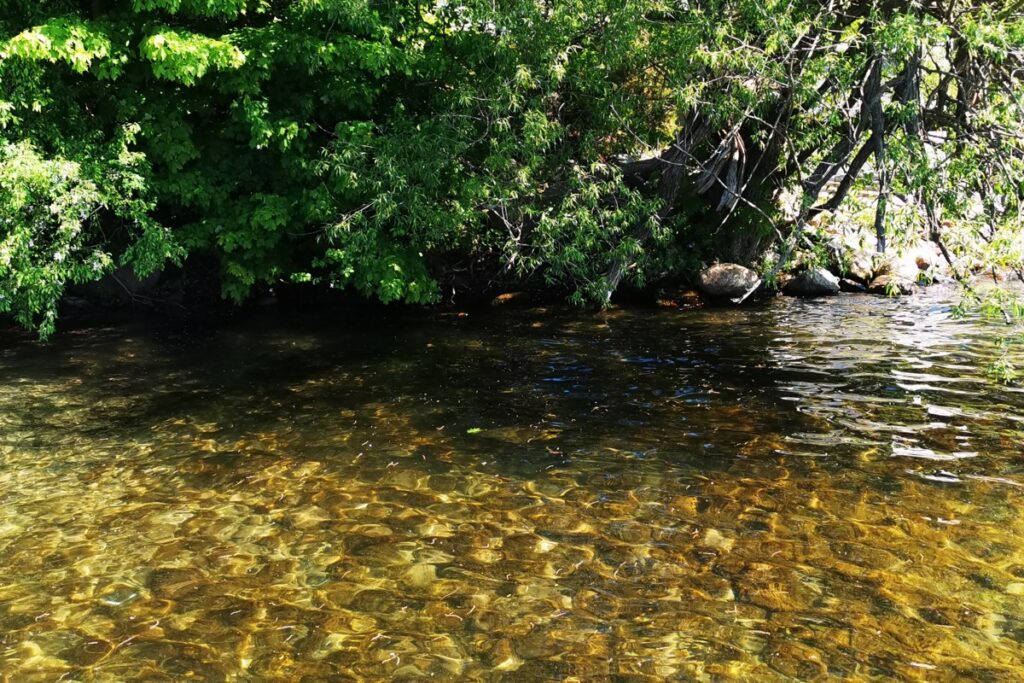“We will work with landowners to recommend native plants such as trees, grasses, shrubs and wildflowers,” officials say.
The Simcoe Muskoka District Health Unit website lists more than a dozen locations affected by blue-green algae blooms last year.
Two algal blooms in local waterways were so severe that government officials issued advisories warning local residents of the potential health risks to themselves and their pets.
The first warning was issued by health officials in early August after a routine inspection of Aull Lake.
At the time, Springwater Township officials said the entire lake was under alert due to high levels of blue-green algae in the water.
The second advisory was issued in October after the Department of Environment, Conservation and Parks confirmed a blue-green algae bloom was occurring in Bass Lake, located near the intersection of Line 15 North and DeWitt Street in Oro-Medonte Township.
The algae blooms are a growing concern and are one of the reasons the Severn Sound Environmental Association (SSEA) is inviting waterfront property owners in the Severn Sound region, including parts of Springwater and Oro-Medonte, to participate in a new program called “Using Natural Edges to Restore Shores.”
“We've seen a surge in blue-green algae blooms in recent years,” said Sarah Song, SSEA's Inland Lakes Water Quality Management Intern. “Our municipal partners and landowners have been asking us what they can do about it.”
“This project is a way to address several questions about shoreline health, including climate resilience, fish and wildlife habitat and pollutant filtration,” she added.
Song said SSEA staff are working with Watershed Canada and its model site visits and planting programs to develop unique shoreline assessment tools and educational materials.
She said interested landowners will be sent a shoreline self-assessment survey and application, and if selected, SSEA will schedule a free site visit to assess the shoreline and discuss potential reforestation plans.
“Landowners fill it out, and we use that information to compare before and after results to gauge the success of the project and the improvement in shoreline health,” Song says. “The tool is also a great way to educate landowners about what contributes to a healthy shoreline.”
Song said SSEA has the capacity to conduct 10 coastline site visits to assist landowners. The organization has currently received five applications, with one site visit scheduled in at least four municipalities.
“The program is first come, first served, but ideally we'd like to have one in each of the municipalities we work with,” she said.
Approved projects will be provided with a starter kit containing up to 50 plants.
“SSEA will cover 75 percent of the cost of the starter kits,” Song said. “Landowners can purchase a starter kit of 50 native plants/trees for $200.”
“If a landowner wants more than 50 plants, we add it to the planting plan at cost price and fulfill the entire order,” she added.
Song said SSEA plans to source a variety of native plants and trees from local nurseries, with specific selections being made based on landowners' land conditions, which will determine which species to plant.
“There are a variety of benefits, from providing a food source for pollinators to stabilizing the soil,” Song said. “We will work with landowners to encourage native plants, including trees, grasses, shrubs and wildflowers.”
By protecting lake and streambanks with locally adapted native plants, these natural buffers stabilize soils, protect property from erosion, reduce the impacts of flooding, improve water quality, filter pollutants and provide important habitat for a diverse range of wildlife.
Song said landowners who are not selected for the program can still have a positive impact on their own land by simply paying the costs and doing the work themselves.
She recommends property owners leave a three-metre buffer between their lawns and the shoreline, uncut, and ideally with native vegetation. She also suggests property owners avoid protecting shorelines with “hardscape” structures such as seawalls, because they divert wave energy elsewhere and create bigger erosion problems.
“This includes minimizing impervious surfaces to prevent stormwater from running directly off into lakes and rivers,” she said.
Finally, landowners should avoid using chemicals near water, including fertilizers, especially within a three-metre buffer zone, she says.
Short-term benefits include increased habitat for pollinators and wildlife and erosion prevention, she said.
Long-term benefits include improved water quality, better erosion control through developed root systems, resistance to climate change, and regulation of water temperature.
“We're really excited to offer this program and work with landowners to demonstrate that individual efforts can make a big difference in conserving the environment and protecting the lake,” Song said.
For more information, please visit the SSEA website.
To apply for Restore the Shore, contact SSEA at 705-534-7283 or [email protected]The registration deadline is June 1, 2024.
Please also note that while SSEA is committed to assisting with shoreline naturalization projects, our assistance is limited to site visits, guidance, and the provision of native plants. We are not involved in shoreline engineering or related landscaping/construction activities. Landowners are responsible for obtaining any necessary federal, state, and local permits and approvals.



